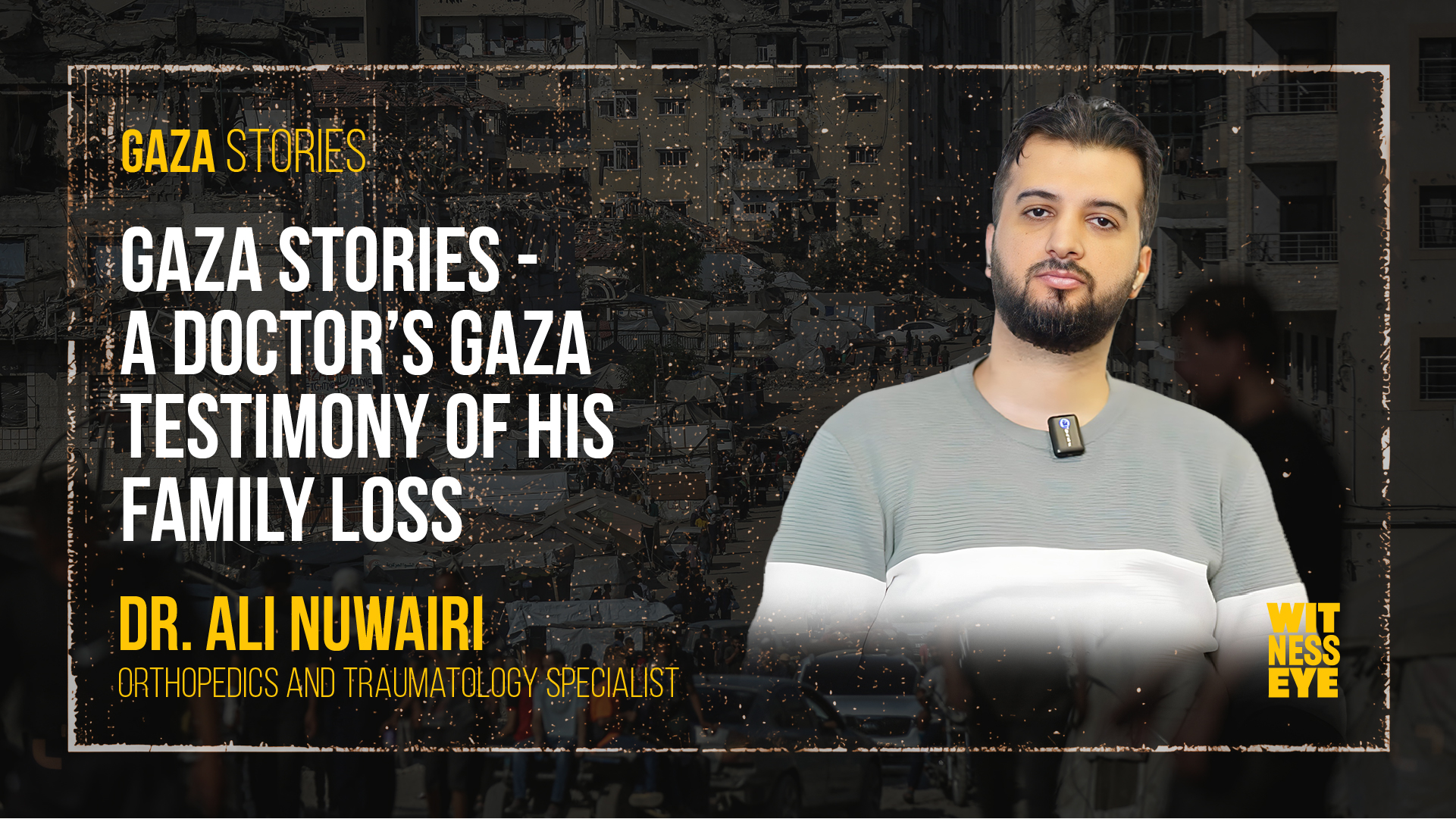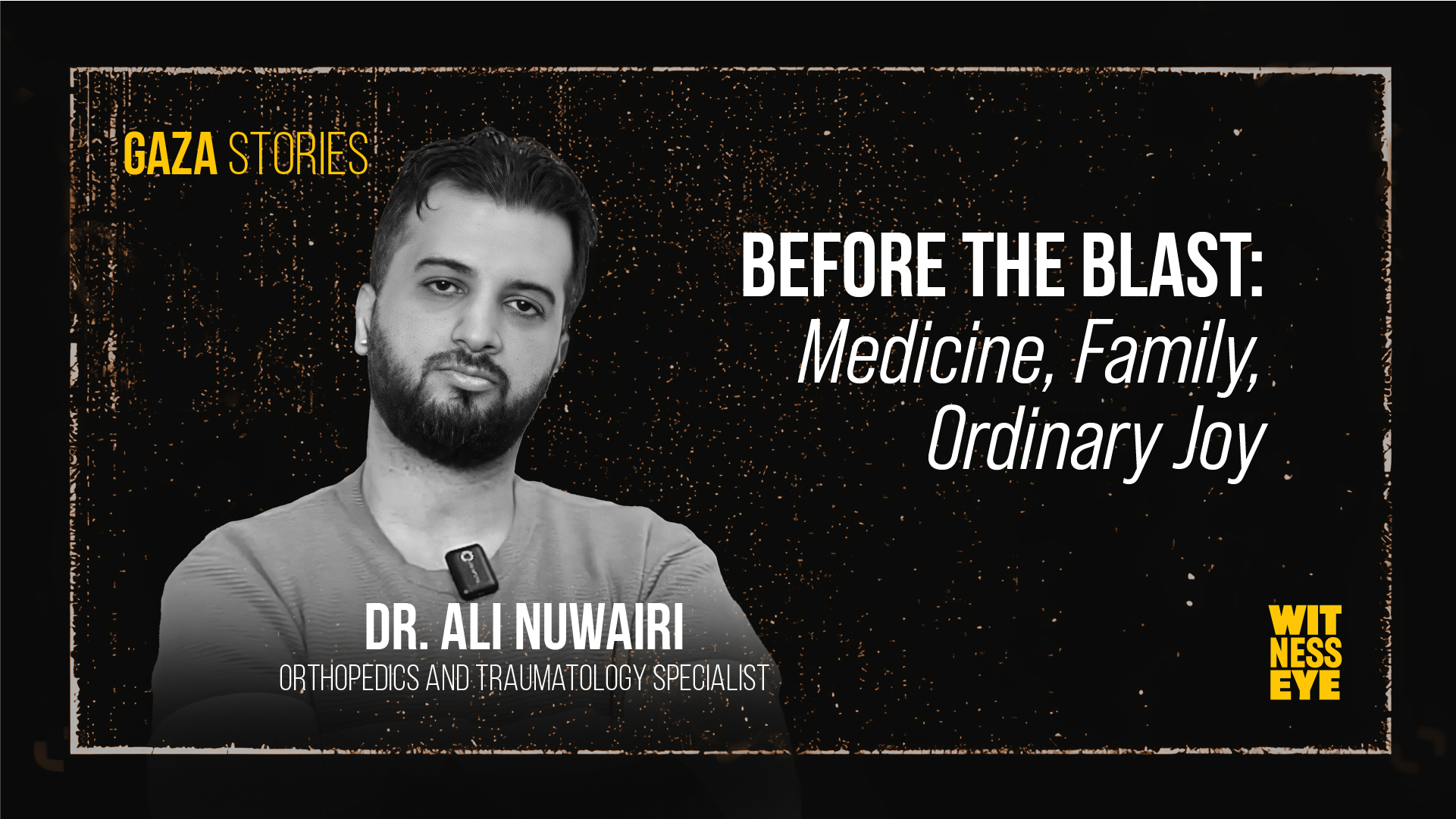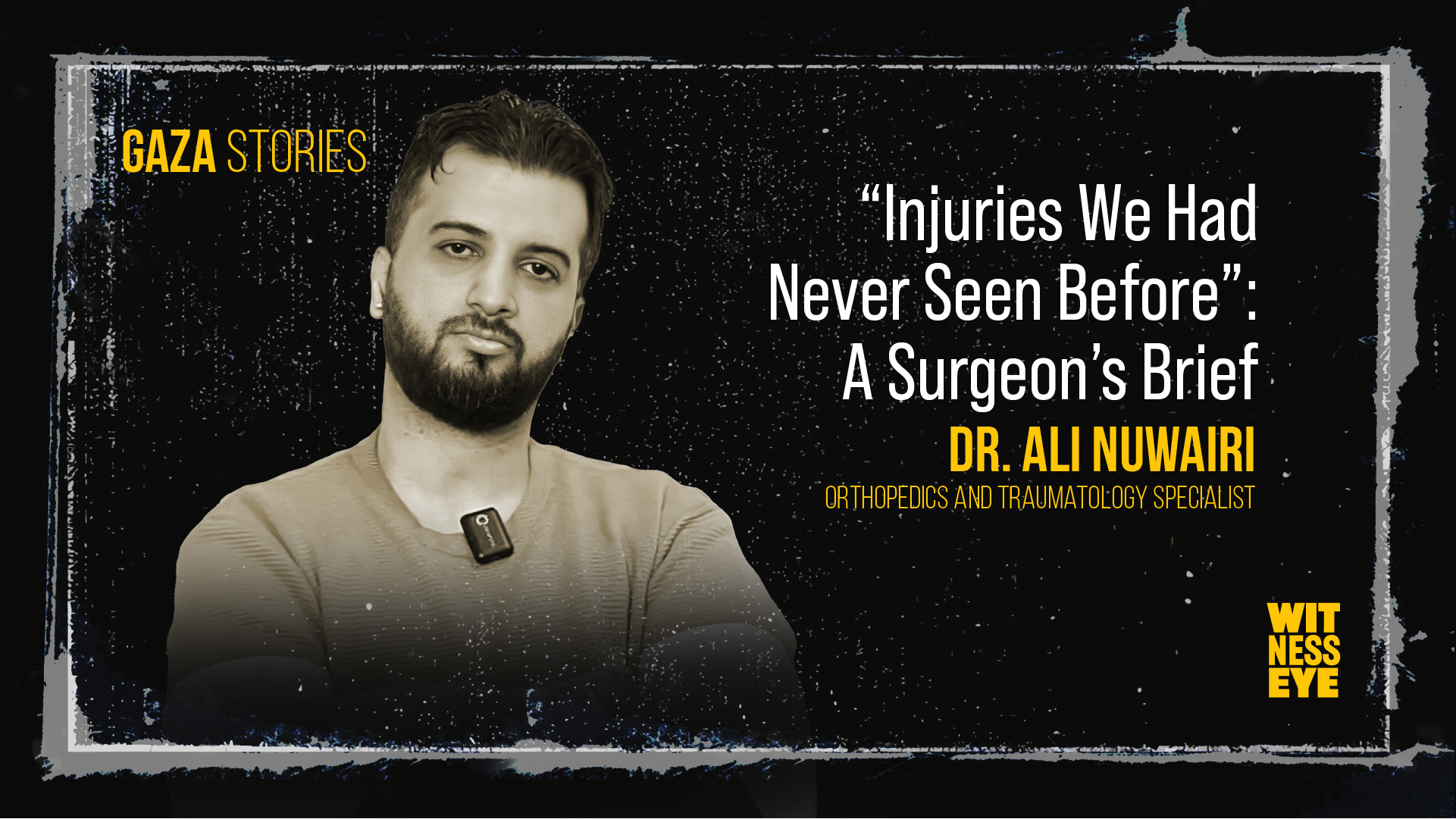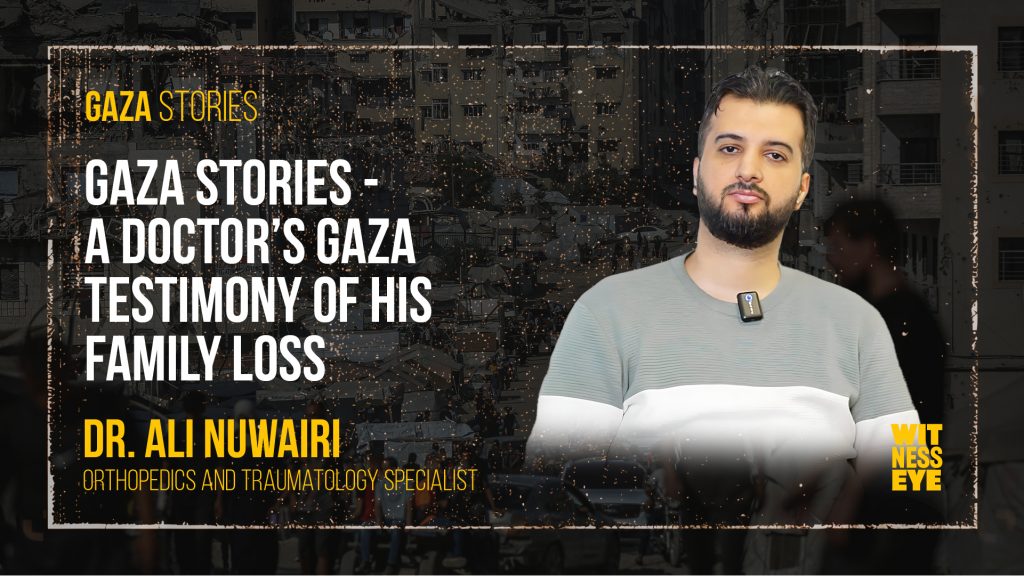
When Gaza Stories set out to document the lives torn open by war, we expected grief and testimony; we did not expect the quiet, precise cadence of a surgeon explaining how a house “broke like a biscuit.” Dr. Ali Hassan Al-Nuwairi, 33, had built a life of rounds and operating rooms—an orthopedic specialist trained at the European Gaza Hospital, later posted to Al-Aqsa Martyrs Hospital. On October 29, the third week of the war, he lay down to rest at noon in his family’s three-story home in Nuseirat. Minutes later he awoke—pinned under concrete, lungs grasping at dust, listening for a voice that could tell him whether he was alive.
“I woke up and found myself trapped under rocks, unable to breathe.”
He would learn in stages, across hospitals and hours, that his spine was fractured, that sensation below the navel had gone, and that the people he loved—his wife, Dr. Enas Al-Haji Youssef, their three-year-old son Hassan, his parents, his brother—were gone too. He remembers how he asked his cousin to make it easier for him. Say yes or no. One by one, the answers came.
“At that moment, I don’t know how to describe the feeling to you… You want to cry, but crying won’t express what’s in your heart.”
This is not a story about miracles. It is a story about witness—and about the systems of accountability that should meet witness with action. It belongs in our Gaza Stories archive because it sits at the crossroads of private loss and public record. Gaza Tribunal because what happened to Dr. Ali’s household is inseparable from patterns we have documented in War Crimes Documentation and Crimes Against Humanity. And it belongs in News because, nearly a year and a half later, its implications for International Humanitarian Law still unfold.
Before the Blast: Medicine, Family, Ordinary Joy
The Nuseirat home knit three generations into a single address. Upstairs, two doctors—Ali and Enas—shared night shifts and holidays with their toddler. On the middle floor, his parents and student sister. On the ground level, his brother, a Ministry of Health nurse, and his dentist wife with their children. It was, he says, “a beautiful life filled with love and harmony. “We would often go out for walks after work… During Ramadan, our communal iftars and evening gatherings—may God have mercy on them.”
When communications to the Strip failed the day before the bombing, he finished a twenty-four-hour shift not knowing if his family was safe. He returned at dawn, ate breakfast with Enas, spoke of the war, then lay down at noon. The surgeon who had spent six years treating shrapnel and fractures went to sleep in what the army itself had labeled a “safe area” south of Wadi Gaza.
“It seemed absolutely impossible that the house would be bombed. There were no wanted persons, no military installations—civilian people.”
That impossibility shattered at 12:00.
Under Rubble, Between Worlds
Neighbors pulled him from debris and laid him beside what had been the house. Training took over: scan the structure in your mind, rate survivability, calculate odds.
“From my experience in hospitals, the house broke like a biscuit. I said that 99% likely no one was left alive… But I had hope.”
The fracture at L1 left him paralyzed below the navel. There were no supplies for spinal fixation at Al-Aqsa; he was transferred to the European Hospital for emergency surgery. They told him as little as possible. He kept asking for Enas. For Hassan. For his parents.
“Two hours after arriving… they transferred me because equipment had run out. I asked, ‘Is Dr. Enas alive?’ No one answered.”
By morning, his cousin stood at the bedside. Ali asked for the yes/no version. Father and mother? Yes. Brother Ahmed? Yes. Wife? (Silence, then:) Yes. Son? Yes.
He remembers a verse—“Indeed we belong to Allah, and indeed to Him we will return”—and the sudden smallness of the world.
“Thirty years of building yourself—family, home, seven years of study, five years of specialization… In the end, you find yourself deprived of your wife, your son, your family, your house, your job.”
“Injuries We Had Never Seen Before”: A Surgeon’s Brief
Before his own injury, Dr. Ali had worked the third week of the war in what he calls the worst days of his medical life. Twelve-hour rounds that covered “ten percent” of warded patients, then operating theaters until 3 a.m. The injuries defied categories: burns fused with amputations; exposed bone without overlying tissue; arteries ripped away; skull and thoracic trauma stacked onto orthopedic catastrophe.
“You wouldn’t find typical injuries… a leg with nothing visible except bone, the rest of the tissues torn apart with the arteries… complex and very difficult injuries.”
He is not alone in reading the pattern. In our Civilian Impact Reports and Military Conduct Analysis, clinicians and field investigators speak to munition effects consistent with Destruction of Civilian Infrastructure on a broad scale. In the European Gaza Hospital, he says, “dozens or hundreds” of ambulances across the Strip had already been targeted.
“I think only five ambulances remain in the entire Gaza Strip.”
The toll is visible in prosthetics. In the Ankara hotel where he now lives among the wounded, he counts amputations of the children.
“There are about 10 children under 10 who are amputees… there are children as young as one year old with amputated feet. What is their fault?”
These observations echo case clusters we documented in Gaza’s Missing and the Genocide Evidence Files, where Civilian Casualty Mapping aligns with hospital logs and Eyewitness Testimonies.
Targeting the Medical Teams
The interview turns to a specific, harrowing question: were medical teams deliberately targeted? Dr. Ali describes the bombing death of a close colleague and the colleague’s doctor wife days before his own injury, and the detention of other colleagues.
“From the start… I wasn’t the only one in the house working in the medical field. I’m a doctor, my wife is a doctor, my brother is a nurse, his wife a dentist.”
“When you look at the Ministry of Health statistics… most ambulances were targeted… I know many nurses and doctors who were targeted specifically.”
His account reinforces a body of work in War Crimes Documentation and Forensic Investigations, and it belongs within our Accountability Watchlist. It also complements testimonies we previously published—see “Gaza Stories: Final Words—Between Grief and Duty” and “Gaza Stories: Hossam’s Fight to Witness”—where clinicians detailed mass-casualty triage that forces choices no training prepares you for.
“In one strike, in five minutes, you get 100 martyrs and 300 injured… You resort to triage between those who might live and hopeless cases.”
Rehabilitation Far From Home
Surgery spared the spinal cord from complete transection. Rehab in Gaza was impossible; physical therapy centers were “completely destroyed.” He waited a month and a half for a transfer, then reached Turkey. There, the right leg recovered “about one hundred percent.” The left leg lagged for a year; only recently did the knee twitch back.
“Nerve recovery takes a long time… my treatment may continue for years, not months.”
In Ankara, he lives among dozens of wounded Gazans in hotel rooms repurposed into convalescent wards. Each morning he rides to physiotherapy and back. He speaks with gratitude about Turkish medical staff who “stayed with me until the last breath,” adding extra sessions beyond quota, prioritizing Gazan patients at intake, and—crucially—bringing in Arabic-speaking psychologists to navigate trauma.
“They provided us with food and drink, shelter and housing, and complete care… As for psychological support, just arriving in Turkey, I found comfort.”
It is a reminder that Gaza Stories are not only about the moment of harm; they trace the after, the logistics of healing, and the unresolved costs borne by families and by health systems. For deeper legal framing of medical targeting and protections, see our Gaza legal review series and the Gaza Tribunal evidence archive. For the tribunal’s international trajectory, revisit “Gaza Tribunal’s First Public Session in Bosnia” and the tag Bosnia public session.
Law, Justice, and the Weight of Double Standards
Will media exposure and legal pursuit restore even a fraction of what was lost? Dr. Ali’s answer is stark.
“Forget about this completely… all the money in the world and all the courts in the world cannot return what they have lost.”
He does not reject law; he indicts hypocrisy.
“We’ve seen how there has been a double standard… when they freed three prisoners… the whole world was up in arms… while our prisoners suffer greatly and no one looks for them.”
He mentions arrest warrants for Netanyahu and the countries that “turned a blind eye,” concluding, “We are only waiting for divine justice.” This is not the end of the legal road but a map of the gap between international justice in theory and in practice. Where law falls short, Digital Evidence Archive work—video, medical records, geolocation—must build pressure and memory. Our Gaza Tribunal Reports and Legal Accountability Cases track that bridge from testimony to docket.
If contacted, he says, he will testify.
“We must do what we can and leave the rest to the Lord of the worlds… for the people’s right, our right, and my family’s right.”
“The Passion for Life Has Been Erased from Us”
The hardest line in the interview may be the quietest.
“Even the passion for life… has been erased from us.”
He is not speaking only for himself. He is speaking for a medical corps working “without salaries,” for colleagues triaging hundreds from a single blast, for students who no longer have a hospital to train in. Al-Shifa, the Strip’s largest hospital and a core engine of specialty training, is “completely destroyed.”
Rebuilding will require more than walls. It will need Expert witness Gaza testimonies, Social Media Evidencetriage, Forensic Investigations, and sustained Gaza justice work that holds patterns together until courts must look. It will also require the intimate stamina of Stories of Survival, the domestic detail that refuses to vanish.
For a broader continuum, see “Gaza Stories: A Mother’s Last Words, A Family’s Goodbye” and “Gaza Stories: A Test for Humanity—When Law Collapses (Part 2)”. Each piece threads personal voice into the fabric of human rights violations Gaza.
Rebuilding Life, Rebuilding Gaza
So how, then, to live? The answer is not romantic. It is procedural: set goals, go to therapy, test the knee again tomorrow, return to the hotel, sleep, rise, repeat.
“Happiness will certainly be incomplete… I try to set goals for myself… maybe tomorrow will be better.”
He imagines the youth cohort of Gaza’s doctors: some training abroad, many returning, all needing hospitals that exist. The first task, he says, is to rebuild health services. Only then can vocation flow back into place.
“We are a people connected to our land… No matter how far we go, we will certainly return.”
As Gaza Stories editors, we place his voice alongside hundreds like it in Witness Eye—under the Besa Witness Eye commitment to fidelity and care. We cross-link it with Gaza war crimes dossiers and Gaza Tribunal timelines. We connect it to earlier profiles such as “Gaza Stories: Journalist, Exile, War” and “Gaza Justice: Voices of Justice and Grief from Gaza”, because no single testimony can bear the weight alone.
“Everything you’ve built in your life goes in a single moment… You won’t take anything to the grave except your good deeds.”
That last line is not an ending. It is a standard: to do the next good, to log the next fact, to keep the Gaza Stories ledger clear. For the families, the courts and the record.
Now, hear the testimony of Dr. Ali Hassan Al-Nuwairi in his own words—orthopedic surgeon, survivor, and witness—carrying Gaza’s grief, memory, and unyielding call for justice into the record of history.
Further Reading (Internal)
-
Tribunal context: Gaza Tribunal’s First Public Session in Bosnia · Bosnia public session
-
Missing & mapping: Gaza’s Missing—Thousands Lost in the Shadow of War · Civilian Casualty Mapping
-
Law & evidence: Gaza legal review · Digital Evidence Archive · Legal Accountability Cases
-
More Gaza Stories: A Mother’s Last Words · Hossam’s Fight to Witness · Journalist, Exile, War
Published By Besa Witness Eye
Stay Connected with Witness Eye
Follow us on our official channels:



